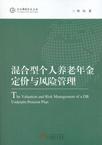混合型个人养老金定价与风险管理
2011-12
中央编译出版社
陈凯
143
无
Hybrid pension plans offer employees the best features of both
defned beneft and defned contribution plans. In this work, we
consider the hybrid design offering a defned contribution beneft
with a defned beneft guaranteed minimum underpin. This study
applies the contingent claims approach to value the defned
contribution beneft with a defned beneft guaranteed minimum
underpin. The study shows that entry age, utility function
parameters and the market price of risk each has a significant
effect on the value of retirement
benefits.
We also consider risk management
for this defned beneft underpin pensionplan. Assuming fxed interest
rates, and assuming that salaries can be treated as a tradable
asset, contribubion rates are develop tor the Entry Age
Normal(EAN), Pro jected Unit Credit(PUC), and Traditional Unit
Credit(TUC)funding methods.For the EAN, the contribution rates are
constant throughont the service period. However, the hedge
parameters for this method are not tradable. For the accruals
method, the individual contribution rates are not constant. For
both the PUC and TUC,a delta hedge strategy is derived and
explained.
The analysis is extended to
relax the tradable assumption for salaries, using the inflation as
a partial hedge. Finally, methods for incorporating volatility
reducing and risk management are
consddered.
Chapter 1 Introduction
Chapter 2 Current Pension systems and Pension Fund Risk
Management
2.1 Defned Beneft Plan
2.2 Funding Methods for DB Plans
2.3 Defned Contribution Plan
2.4 Pension Reform
2.5 Hybrid Pension Plans
Chapter 3 The Valuation of a DB Underpin Pension
3.1 Introduction
3.2 The Model and Assumptions
3.3 Numerical Techniques
3.4 Results
3.5 Scenario Test
Chapter 4 Funding Strategies with Two Traded Assets
4.1 Introduction to Risk Management
4.2 Assumptions
4.3 Margrabe Option
4.4 Strategy 1:EAN Cost Method
4.5 Strategy2:EAN Cost Method
4.6 Strategy3:PUC Cost Method
4.7 Strategy4:TUC Cost Method
4.8 Summary
Chapter 5 Numerical Examples of Hedging Costs
5.1 Introduction
5.2 Numerical Simulation
5.3 Hedging Costs
5.4 Scenario Tests
Chapter 6 Salary, Infation, and Equity Returns
6.1 Ob jectives
6.2 Data Analysis
6.3 Selection of Hedging Assets
Chapter 7 Hedging Costs
7.1 Introduction
7.2 The Model for Salary and Infation
7.3 Numerical Results
Chapter 8 Hedging with Stochastic Interest Rates
Chapter 9 Costs Control
Chapter 10 Comments and Further Work
Bibliography
版权页:插图:A pure defned contribution plan is a pension scheme where only contributions are fxed and benefts therefore depend on returns on the assets of the fund. Pension benefts are totally defned by the investment performance and employees make investment decisions. All investment risk is transferred to employees. The pension benefts may be very low when employees make bad, or unlucky investment decisions or the fnancial market is poor.Defned contribution plans have been far more popular recently for two main reasons. First, an employee knows the value of his or her retirement account at any time; his or her plan is then more easily portable from a company to another one. Moreover, employers do not bear any risk linked with the retirement system of companies. The problem here is the real need for a downside protection for employees. The ultimate aim of a pension plan is to fnance retirement and it usually provides the most important source of employees' incomes after retirement. To provide some down side protection,some plans incorporate guarantees or top-ups for when the beneft is very low. The main problem considered in this thesis is the DB minimum,which has not been much written about in the scientifc literature. However,there are other forms of DC guarantees, with some relevant academic research.
《混合型个人养老金定价与风险管理(英文版)》为当代中国学术文库之一。

无